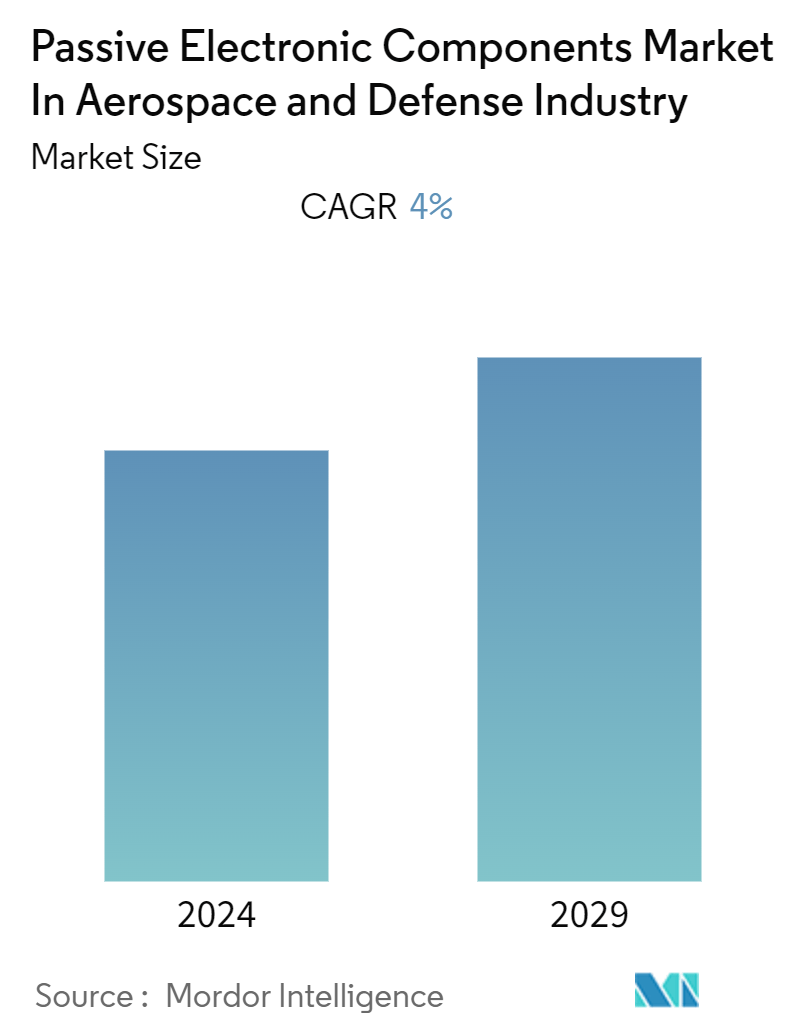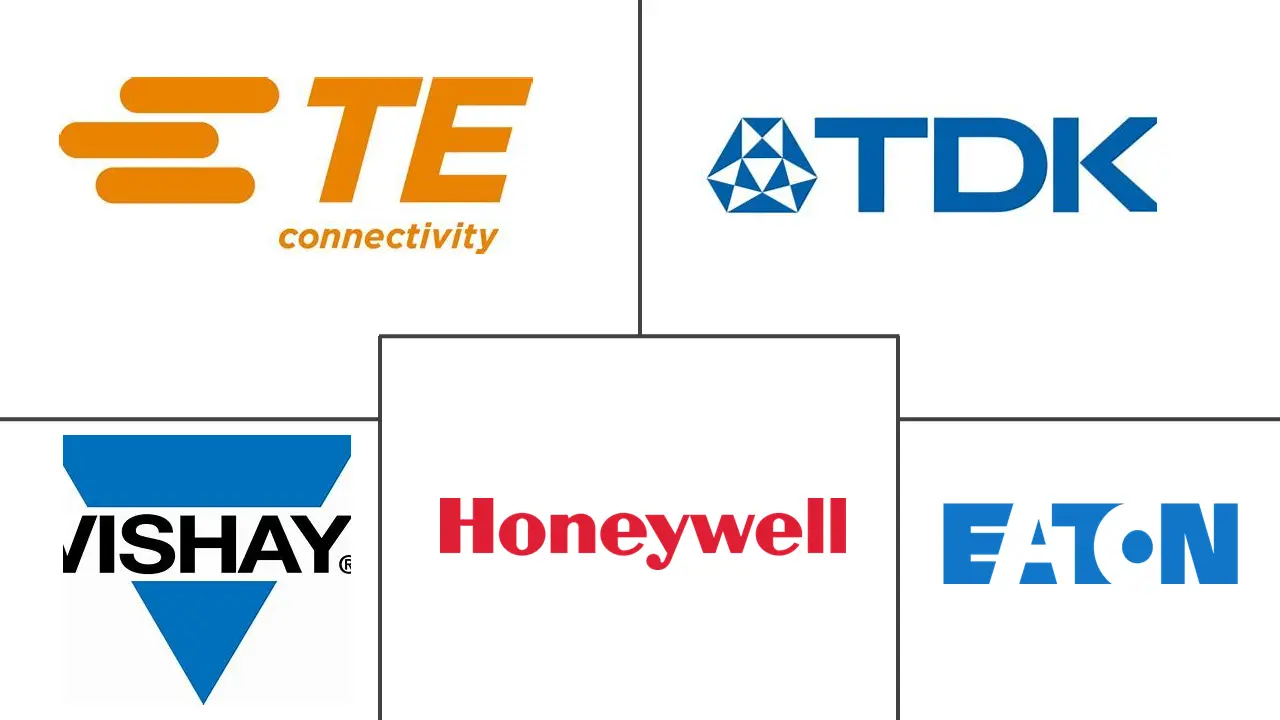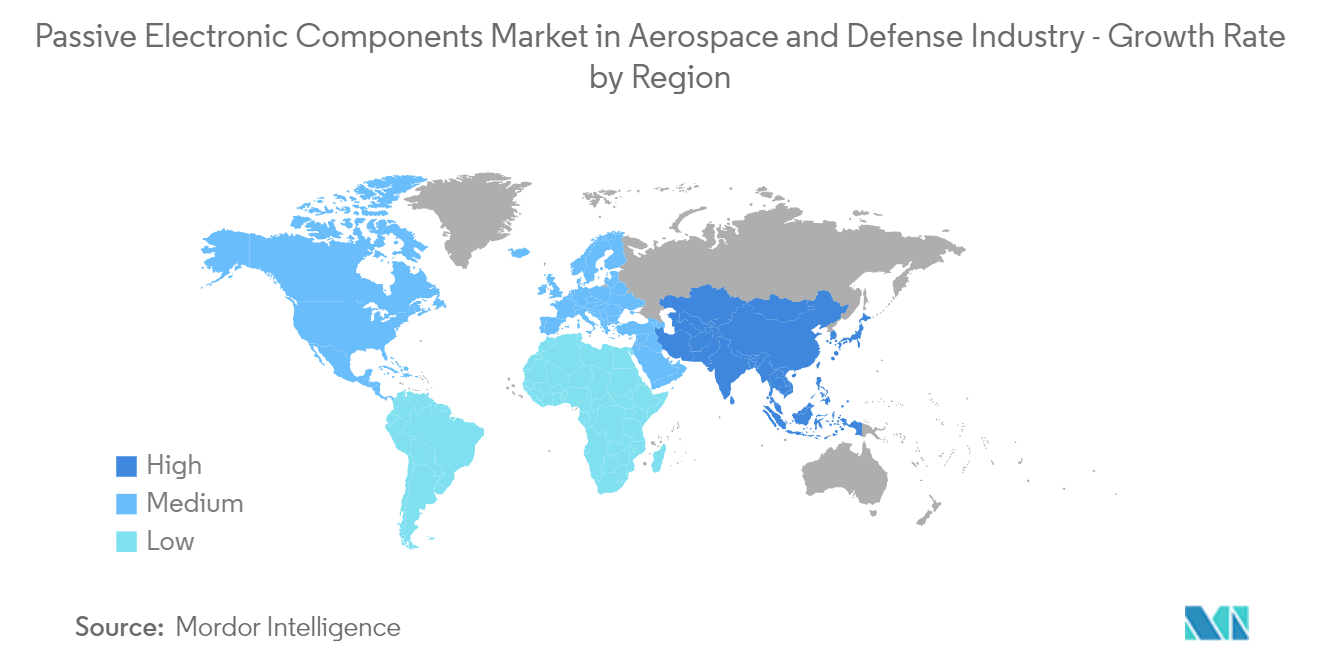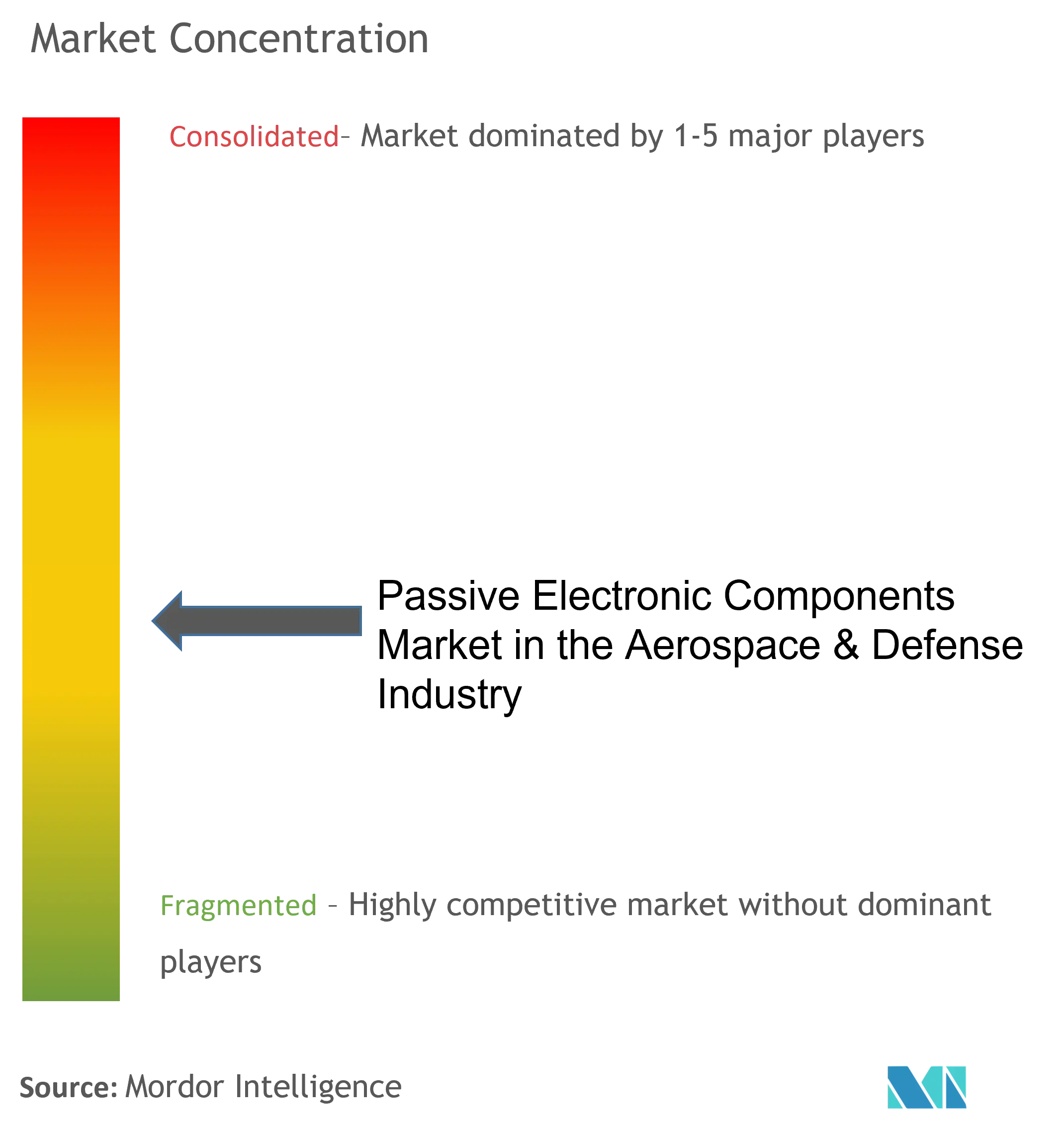Passive Electronic Components Market Size

| Study Period | 2022 - 2029 |
| Base Year For Estimation | 2023 |
| CAGR (2024 - 2029) | 4.00 % |
| Fastest Growing Market | Asia Pacific |
| Largest Market | North America |
| Market Concentration | Medium |
Major Players
*Disclaimer: Major Players sorted in no particular order |
Passive Electronic Components Market Analysis
The Passive Electronic Components Market In Aerospace & Defense Industry is expected to register a CAGR of 4% during the forecast period.
The demand for passive electronics components in the aerospace and defense industry is projected to increase during the projected timeline. The defense electronics systems have to function reliably for their life while operating at broader temperature ranges and higher voltages, all while becoming lighter, smaller, and consuming less power.
- According to NASA, its spacecraft and various electronic devices are exposed to extreme radiation around Jupiter, which can cause significant damage. In executing several missions, NASA requires exceptionally reliable and durable high-voltage resistors for this application. Previously, companies such as Ohmcraft partnered with NASA to provide their resistors incorporated in NASA's Juno spacecraft to explore Jupiter.
- The rise in the demand for commercial and defense aircraft is one of the major factors driving the growth of the passive electronic components market in the aerospace & defense industry. Moreover, commercial aircraft manufacturers are expanding their manufacturing capacity to meet the rising demand for new aircraft, further supporting the growth of passive electronic components in the aerospace & defense industry.
- For instance, in February 2023, Air India, the Tata Group-owned carrier, announced the order for new and next-generation aircraft from manufacturers Boeing and Airbus. The company ordered 470 aircraft comprising 40 Airbus 350, 10 Boeing 777-9s, 20 Boeing 787, 190 Boeing 737 MAX single-aisle aircraft, and 210 Airbus A320/321 Neo.
- Moreover, many companies focus on developing military-grade passive electronic components to meet the demanding military and high-reliability application requirements. For instance, in February 2022, Gowanda Electronics announced the introduction of SMP0603, its first ceramic core chip inductor series for power applications. These high-performance chip inductors can also be utilized in RF applications in the military markets and are ideal for use in test and measurement, industrial control, and automotive sectors.
- Furthermore, the market is also witnessing increased adoption of Tantalum capacitors. For instance, KEMET recently introduced KO-CAP, a new line of Tantalum capacitors with a rated voltage of 2.5V to 63V and a capacitance of 10-1000 microfarad for a temperature of 105 to 125 degree Celsius for harsh operating conditions in military and aerospace.
Passive Electronic Components Market Trends
Increase in Defense Spending is Expected to Propel the Industry's Growth
- The rising defense budgets advance the defense sector and, due to rising geographical tension with various countries, also provide significant growth opportunities for passive electronic components in the aerospace & defense industry. For instance, to digitize, the US government signed off on a USD 29 billion spending increase to request the fiscal year 2022 national defense budget. Moreover, the national defense total in the 2022 omnibus spending bill had been USD 782 billion, a 3.9% increase over the administration's request for 2022 and a 5.6% increase over the 2021 appropriations.
- In March 2023, the government of China announced a 7.2% increase in its defense budget for the coming year. China also has a large stockpile of missiles, stealth aircraft, nuclear-capable bombers, advanced surface ships, and nuclear submarines.
- Similarly, in March 2023, the UK government announced spending USD 6 billion in defense to meet the challenges of an increasingly complex and volatile world. The government aims to modernize the UK's nuclear enterprise through this investment and bolster vital ammunition stocks. Such massive spending on defense will increase the demand for passive electronic components.
- Many European countries have increased their defense spending following Russia's invasion of Ukraine. Also, in November 2022, the European Union's Defense Minister approved a significant increase in the budget of the European Defense Agency (EDA) for 2023. This reflects the European Union's more ambitions and concrete strengthening of its institutions to support its growing defense efforts. The EDA budget for 2023 is expected to increase by 15% compared to 2022 to EUR 43.5 million. The increase is expected to help enhance domain expertise on land, air, sea, space, and cyber.
- The rise in the spending on the military sector by various countries is pushing the market players in the region to develop new products to meet the specifications of the defense. For instance, in May 2022, Vishay Intertechnology Inc. introduced a new thin-film wraparound chip resistor for military and aerospace applications. They are available in four case sizes from 0402 to 1206; these resistors have a high power rating of 1W in the 1206 case size (no underboard cooling).

Asia Pacific to Witness Significant Growth
- Asia-Pacific is significantly investing in the aerospace & defense industry to improve military infrastructure and modernize the defense system. According to IBEF, the Ministry of Defence has been allocated a total budget of USD 72 billion which is 13.18 % of the total budget. The defense budget represents an enhancement of USD 8.35 billion, which is 13% more than in 2022-23.
- Japan has potential growth opportunities in the studied market due to the rise in technology penetration, high defense spending, and the presence of many small and medium enterprises (SMEs). In December 2022, Prime Minister Fumio Kishida instructed his defense and finance ministers to hike the country'scountry's defense spending by more than 50% over five years to around JPY 43 trillion (USD 326 billion).
- With the increasing defense sector in the country's heightened investment in advanced electronic systems, thereby the use of passive electronic components is projected to grow. They are widely used in power supplies, communication & navigation, displays & controls, optics & sensors, computing & networking, and among others.
- Moreover, the Indian government's initiative to expand domestic arms production demonstrates the country's determination to become more self-sufficient in the sector. Indian companies are partnering with foreign companies to showcase jointly developed capabilities in line with Make in India requirements, creating additional new growth opportunities for vendors operating in the studied market.
- Furthermore, South Korea is increasing its investment in space technology to strengthen its defense capabilities in outer space. The country is making efforts to develop core technologies for military satellites. Additionally, in March 2023, the Korean government announced to invest USD 38.5 million in private space startups by 2027.
- South Korea's defense industry is very much successive and growing. In addition, by 2027, the South Korean government plans to invest 1.5 trillion won (USD 1.16 billion) in defense technology development as part of a program including private-military collaboration. These trends will maximize the use of passive electronic components.
- In addition, in August 2022, Taiwan announced to invest USD 19 billion in defense spending for next year, a double-digit increase in 2022, including funding for new fighter planes, just weeks after China held large-scale military exercises around the island it views as its territory.

Passive Electronic Components Industry Overview
The passive electronic components market is fragmented due to several market players globally. The market players are making several product developments and innovations to capture the maximum market share. Moreover, the market players are considering strategic partnerships and investments to gain maximum market traction.
- March 2023: KEMET Corporation, a part of YAGEO Group, announced the new polymer Tantalum capacitors surface mount T580/T581 series. This series supports Military Performance Specification Sheets MIL-PRF-32700/1 and /2. The company aims to strengthen its leadership in the defense & aerospace high-reliability application market through this launch.
- February 2023: Kyocera AVX announced that its MIL-PRF-32535 BME NP0 MLCCs had been approved by the Defense Logistics Agency (DLA) Qualified Products Database (QPD). MIL-PRF-32535 BME NP0 MLCCs are approved for use in high-reliability military and aerospace applications, including tuning, filtering, decoupling, blocking, and timing circuits.
Passive Electronic Components Market Leaders
-
TE Connectivity
-
Vishay Intertechnology Inc.
-
TDK Corporation
-
Honeywell International Inc.
-
Eaton Corporation
*Disclaimer: Major Players sorted in no particular order

Passive Electronic Components Market News
- April 2023: Cornell Dubilier Electronics Inc. announced a new line of standard supercapacitor modules. The DSM series addresses the need for supercapacitor storage capability at higher voltages than individual devices can provide. The new modules come in packs of 6, 3, or 10 cells in series for 18V, 9V, and 30V outputs.
- March 2023: API Delevan announced to release of its S0603 and S0402, a small high-reliability space SMD inductor, which is designed to meet space, downhole, medical, and other harsh environment engineering challenges. This inductor is ideal for space and aerospace applications. It provides excellent temperature stability, low outgassing properties, high Q and ultra-high SRF values, and an operating temperature range of -55 to +125 C degrees.
Passive Electronic Components Market In Aerospace & Defense Industry Market Report - Table of Contents
1. INTRODUCTION
- 1.1 Study Assumptions and Market Definition
- 1.2 Scope of the Study
2. RESEARCH METHODOLOGY
3. EXECUTIVE SUMMARY
4. MARKET INSIGHTS
- 4.1 Market Overview
-
4.2 Industry Attractiveness - Porter's Five Forces Analysis
- 4.2.1 Threat of New Entrants
- 4.2.2 Bargaining Power of Buyers
- 4.2.3 Bargaining Power of Suppliers
- 4.2.4 Threat of Substitute Products
- 4.2.5 Intensity of Competitive Rivalry
- 4.3 Industry Value Chain Analysis
- 4.4 Assesment of the Impact of COVID-19 on the Market
- 4.5 Analysis of Key Applications of Passive Electronics Components in the Aerospace & Defense Industry (Avionics, Communications and Navigation, Satellites, Etc.)
5. MARKET DYNAMICS
-
5.1 Market Drivers
- 5.1.1 Increasing Usage of Advanced Electronic Devices in Aerospace & Defense Industry
-
5.2 Market Restraints
- 5.2.1 Increasing Price of Critical Metals Used in Manufacturing of Passive Electronic Components
6. MARKET SEGMENTATION
-
6.1 By Type
- 6.1.1 Capacitors
- 6.1.2 Inductors
- 6.1.3 Resistors
-
6.2 By Geography
- 6.2.1 North America
- 6.2.2 Europe
- 6.2.3 Asia
- 6.2.4 Australia and New Zealand
7. COMPETITIVE LANDSCAPE
-
7.1 Company Profiles
- 7.1.1 KEMET Corporation (Yageo Company)
- 7.1.2 Panasonic Corporation
- 7.1.3 TDK Corporation
- 7.1.4 Vishay Intertechnology Inc.
- 7.1.5 AVX Corporation (Kyocera Corporation)
- 7.1.6 Taiyo Yuden Co. Ltd
- 7.1.7 WIMA GmbH & Co. KG
- 7.1.8 Cornell Dubilier Electronics Inc.
- 7.1.9 API Delevan ( Fortive Corporation)
- 7.1.10 Bourns Inc.
- 7.1.11 TE Connectivity
- 7.1.12 Eaton Corporation
- 7.1.13 TT Electronics PLC
- 7.1.14 Ohmite Manufacturing Company
- 7.1.15 Honeywell International Inc.
- *List Not Exhaustive
8. INVESTMENT ANALYSIS
9. MARKET OPPORTUNITIES AND FUTURE TRENDS
** Subject To AvailablityPassive Electronic Components Industry Segmentation
Passive electronic components absorb the power and convert it into heat or store it in a magnetic or electric field. A passive module is not a source of energy and is incapable of power gain.
The passive electronic components market in the aerospace and defense industry is segmented by type (capacitors, inductors, and resistors) and geography (North America, Europe, Asia-Pacific, and Rest of the World). The market sizes and forecasts are provided in terms of value (USD) for all the above segments.
| By Type | Capacitors |
| Inductors | |
| Resistors | |
| By Geography | North America |
| Europe | |
| Asia | |
| Australia and New Zealand |
Passive Electronic Components Market In Aerospace & Defense Industry Market Research Faqs
What is the current Passive Electronic Components Market In Aerospace & Defense Industry size?
The Passive Electronic Components Market In Aerospace & Defense Industry is projected to register a CAGR of 4% during the forecast period (2024-2029)
Who are the key players in Passive Electronic Components Market In Aerospace & Defense Industry?
TE Connectivity, Vishay Intertechnology Inc., TDK Corporation, Honeywell International Inc. and Eaton Corporation are the major companies operating in the Passive Electronic Components Market In Aerospace & Defense Industry.
Which is the fastest growing region in Passive Electronic Components Market In Aerospace & Defense Industry?
Asia Pacific is estimated to grow at the highest CAGR over the forecast period (2024-2029).
Which region has the biggest share in Passive Electronic Components Market In Aerospace & Defense Industry?
In 2024, the North America accounts for the largest market share in Passive Electronic Components Market In Aerospace & Defense Industry.
What years does this Passive Electronic Components Market In Aerospace & Defense Industry cover?
The report covers the Passive Electronic Components Market In Aerospace & Defense Industry historical market size for years: 2022 and 2023. The report also forecasts the Passive Electronic Components Market In Aerospace & Defense Industry size for years: 2024, 2025, 2026, 2027, 2028 and 2029.
Passive Electronic Components In Aerospace & Defense Industry Industry Report
Statistics for the 2024 Passive Electronic Components In Aerospace & Defense Industry market share, size and revenue growth rate, created by Mordor Intelligence™ Industry Reports. Passive Electronic Components In Aerospace & Defense Industry analysis includes a market forecast outlook to for 2024 to (2024to2029 and historical overview. Get a sample of this industry analysis as a free report PDF download.
Passive Electronic Components Market In Aerospace & Defense Industry Report Snapshots
- Passive Electronic Components Market In Aerospace & Defense Industry Market Size
- Passive Electronic Components Market In Aerospace & Defense Industry Market Share
- Passive Electronic Components Market In Aerospace & Defense Industry Market Trends
- Passive Electronic Components Market In Aerospace & Defense Industry Companies



